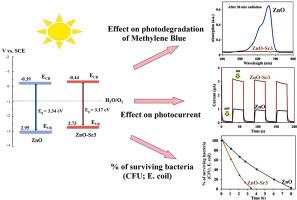当前位置:
X-MOL 学术
›
J. Alloys Compd.
›
论文详情
Our official English website, www.x-mol.net, welcomes your
feedback! (Note: you will need to create a separate account there.)
Synthesis and characterization of Sr-doped ZnO nanoparticles for photocatalytic applications
Journal of Alloys and Compounds ( IF 5.8 ) Pub Date : 2021-02-01 , DOI: 10.1016/j.jallcom.2020.157000 Mohadeseh Yarahmadi , Hossein Maleki-Ghaleh , Masoud Emami Mehr , Ziba Dargahi , Fatemeh Rasouli , M. Hossein Siadati
Journal of Alloys and Compounds ( IF 5.8 ) Pub Date : 2021-02-01 , DOI: 10.1016/j.jallcom.2020.157000 Mohadeseh Yarahmadi , Hossein Maleki-Ghaleh , Masoud Emami Mehr , Ziba Dargahi , Fatemeh Rasouli , M. Hossein Siadati

|
Abstract The use of semiconductors that respond to the visible light as a photocatalyst is an effective way to remove pollution resulting from the chemical industries. In this project, with the aim of increasing its photocatalytic activity, zinc oxide (ZnO) was doped with 1, 3, 5 and 7 M% strontium (Sr) by mechanical milling method. Characterization of the synthesized powders was done by X-ray diffraction (XRD), field emission scanning electron microscopy (FE-SEM) and energy dispersive spectroscopy (EDS). The optical behavior was evaluated using UV–Vis diffuse reflectance spectra (UV–Visible DRS) and photoluminescence. The XRD results showed successful doping of Sr in ZnO. The results of microscopic characterization revealed that the size of Sr-doped particles was in the range of 20–60 nm. Just about all results showed that the 3% Sr-doped ZnO sample (ZnO–Sr3) revealed the best performance. Its band gap decreased from 3.34 to 3.17 eV. Investigated by radiation of the HMI lamp for degradation of methylene blue (MB) dye, the photocatalytic efficiency of ZnO–Sr3 sample increased from 56 to 97%. Also, the results of chronoamperometry test showed a 3-fold increase in the photocurrent of ZnO–Sr3. Antibacterial studies of the samples on Escherichia coli (E. coli) bacterium also revealed that the ZnO–Sr3 sample had the highest antibacterial property.
中文翻译:

用于光催化应用的 Sr 掺杂 ZnO 纳米粒子的合成和表征
摘要 使用响应可见光的半导体作为光催化剂是去除化学工业污染的有效途径。在该项目中,为了提高其光催化活性,氧化锌 (ZnO) 通过机械研磨法掺杂了 1、3、5 和 7 M% 的锶 (Sr)。通过 X 射线衍射 (XRD)、场发射扫描电子显微镜 (FE-SEM) 和能量色散谱 (EDS) 对合成粉末进行表征。使用 UV-Vis 漫反射光谱(UV-Visible DRS)和光致发光来评估光学行为。XRD 结果表明 Sr 成功掺杂在 ZnO 中。显微表征结果表明,Sr 掺杂颗粒的尺寸在 20-60 nm 范围内。几乎所有结果都表明,3% Sr 掺杂的 ZnO 样品 (ZnO-Sr3) 表现出最佳性能。其带隙从 3.34 eV 降低到 3.17 eV。通过 HMI 灯辐射降解亚甲蓝 (MB) 染料进行研究,ZnO-Sr3 样品的光催化效率从 56% 增加到 97%。此外,计时电流法测试的结果显示 ZnO-Sr3 的光电流增加了 3 倍。对大肠杆菌(E.coli)细菌样品的抗菌研究还表明,ZnO-Sr3 样品具有最高的抗菌性能。计时电流法测试的结果显示 ZnO-Sr3 的光电流增加了 3 倍。对大肠杆菌(E.coli)细菌样品的抗菌研究还表明,ZnO-Sr3 样品具有最高的抗菌性能。计时电流法测试的结果显示 ZnO-Sr3 的光电流增加了 3 倍。对大肠杆菌(E.coli)细菌样品的抗菌研究还表明,ZnO-Sr3 样品具有最高的抗菌性能。
更新日期:2021-02-01
中文翻译:

用于光催化应用的 Sr 掺杂 ZnO 纳米粒子的合成和表征
摘要 使用响应可见光的半导体作为光催化剂是去除化学工业污染的有效途径。在该项目中,为了提高其光催化活性,氧化锌 (ZnO) 通过机械研磨法掺杂了 1、3、5 和 7 M% 的锶 (Sr)。通过 X 射线衍射 (XRD)、场发射扫描电子显微镜 (FE-SEM) 和能量色散谱 (EDS) 对合成粉末进行表征。使用 UV-Vis 漫反射光谱(UV-Visible DRS)和光致发光来评估光学行为。XRD 结果表明 Sr 成功掺杂在 ZnO 中。显微表征结果表明,Sr 掺杂颗粒的尺寸在 20-60 nm 范围内。几乎所有结果都表明,3% Sr 掺杂的 ZnO 样品 (ZnO-Sr3) 表现出最佳性能。其带隙从 3.34 eV 降低到 3.17 eV。通过 HMI 灯辐射降解亚甲蓝 (MB) 染料进行研究,ZnO-Sr3 样品的光催化效率从 56% 增加到 97%。此外,计时电流法测试的结果显示 ZnO-Sr3 的光电流增加了 3 倍。对大肠杆菌(E.coli)细菌样品的抗菌研究还表明,ZnO-Sr3 样品具有最高的抗菌性能。计时电流法测试的结果显示 ZnO-Sr3 的光电流增加了 3 倍。对大肠杆菌(E.coli)细菌样品的抗菌研究还表明,ZnO-Sr3 样品具有最高的抗菌性能。计时电流法测试的结果显示 ZnO-Sr3 的光电流增加了 3 倍。对大肠杆菌(E.coli)细菌样品的抗菌研究还表明,ZnO-Sr3 样品具有最高的抗菌性能。











































 京公网安备 11010802027423号
京公网安备 11010802027423号